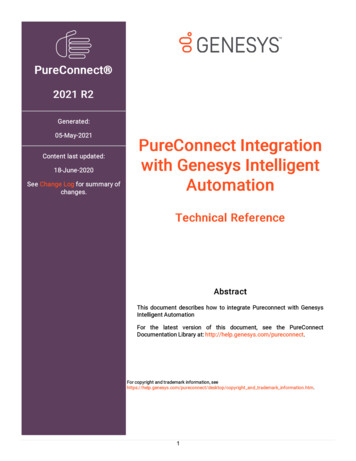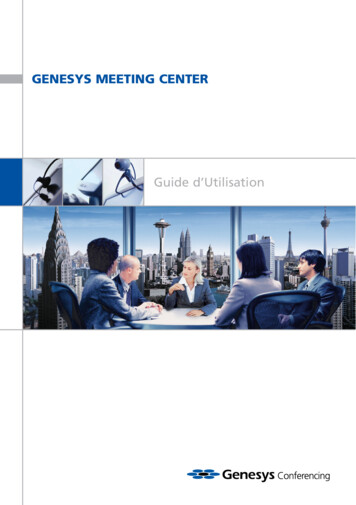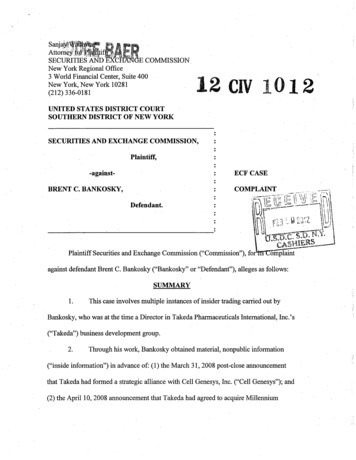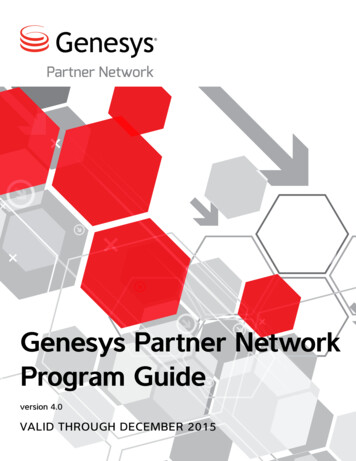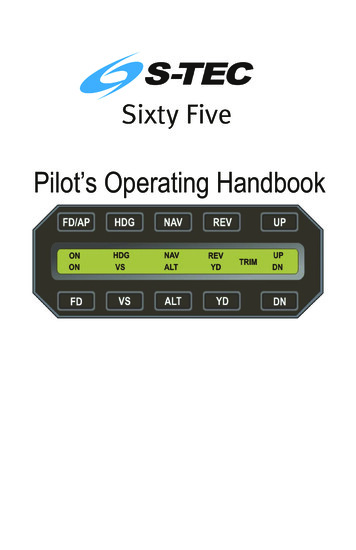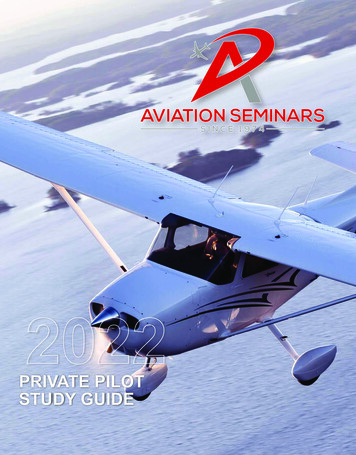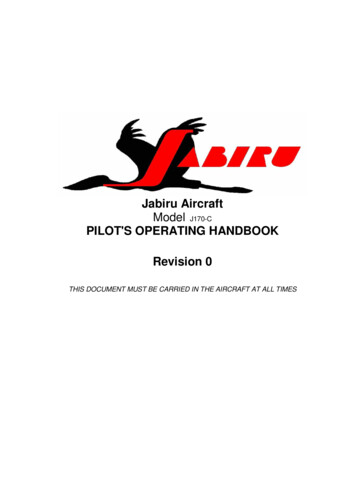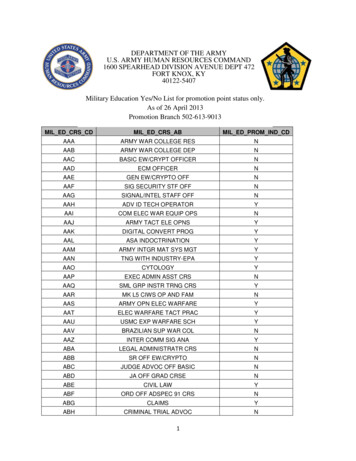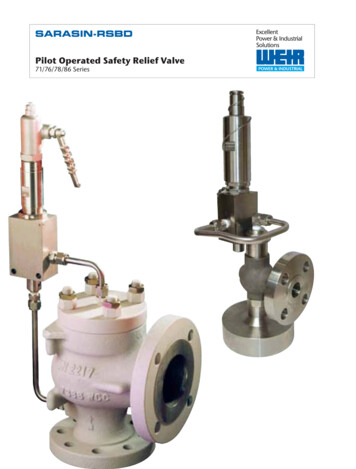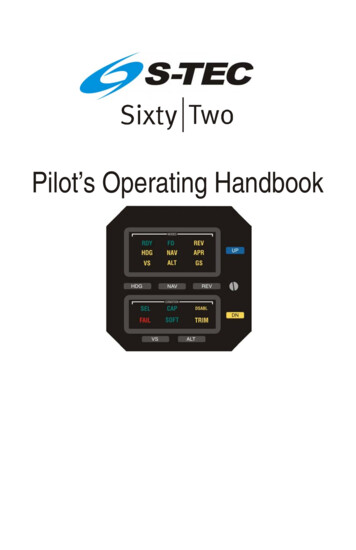
Transcription
Pilot’s Operating Handbook
S–TECList of Effective Pages* Asterisk indicates pages changed, added, or deleted bycurrent revision.Record of RevisionsRetain this record in front of handbook. Upon receipt of arevision, insert changes and complete table below.Revision NumberstRevision Date1 Ed.nd2 Ed.Mar 29, 99Nov 01, 013rd Ed.Jun 30, 073rd Ed. Jun 30, 07Insertion Date/Initialsi
S–TECPage Intentionally Blankii3rd Ed. Jun 30, 07
S–TECTable of ContentsSec.1Pg.Overview.1–11.1Document Organization.1–31.2Purpose.1–31.3General Control Theory.1–31.4Modes of Operation.1–41.52Roll Axis Control.1–41.4.2Pitch Axis Control.1–4Block Diagram.1–4Pre-Flight Procedures.2–12.131.4.1Pre-Flight Test.2–3In-Flight Procedures.3–13.1Normal Operating Procedures.3–33.1.1Heading (HDG) Mode.3–33.1.2Navigation (NAV) Mode.3–33.1.2.1 Pilot Selectable Intercept Angle.3–63.1.3Altitude Hold (ALT HOLD) Mode.3–73.1.4Vertical Speed (VS) Mode.3–83.1.5Elevator Trim.3–93.1.5.1 Manual Elevator Trim.3–93.1.5.2 Automatic Elevator Trim.3–93.1.5.3 Manual Electric Elevator Trim.3–103.2Precision Approach Procedures.3–113.2.1Straight-In ILS Approach.3–113.2.2ILS Approach with Procedure Turn.3–143rd Ed. Jun 30, 07iii
S–TEC3.3Non-Precision Approach Procedures.3–153.3.1Straight-In Back Course Approach.3–153.3.1.1 Pilot Selectable Intercept Angle.3–173.43.543.3.2Back Course Approach with Procedure Turn.3–183.3.3Straight-In LOC Approach.3–223.3.4Straight-In VOR Approach.3–243.3.5LOC Approach with Procedure Turn.3–263.3.6VOR Approach with Procedure Turn.3–30Flight Director Operation.3–343.4.1FD/AP Mode.3–343.4.2FD Mode.3–36Yaw Damper Operation.3–373.5.1AUTO Mode.3–373.5.2ON Mode.3–373.5.3Yaw Damper Trim.3–373.6Autopilot Disconnect .3–383.7Automatic Trim Disable.3–38Operating Parameters.4–14.1Roll Axis Limits.4–34.2Pitch Axis Limits.4–35Glossary.5–1iv3rd Ed. Jun 30, 07
S–TECList of FiguresFig.Pg.1–1System Sixty Two Block Diagram.1–51–2Yaw Damper Block Diagram.1–61–3Flight Director Block Diagram.1–62–1AP Display, RDY for Operation.2–42–2AP Display, Turn Coordinator Failure.2–42–3AP Display, All Annunciations Appear.2–72–4AP Display, HDG Mode Engaged (Pre-Flight).2–72–5AP Display, NAV Mode Engaged, SOFT Condition (Pre-Flight).2–92–6AP Display, HDG and ALT HOLD Modes Engaged (Pre-Flight).2–112–7AP Display, HDG and VS Modes Engaged (Pre-Flight).2–112–8AP Display, HDG and ALT HOLD Modes Engaged,Trim Required (Pre-Flight).2–133–1AP Display, HDG Mode Engaged.3–33–2AP Display, NAV Mode Engaged.3–43–3AP Display, NAV Mode Engaged, CAP Condition.3–53–4AP Display, NAV Mode Engaged, SOFT Condition.3–53–5AP Display, NAV Mode Engaged, SOFT Condition.3–63–6AP Display, HDG Mode Engaged, NAV Mode Armed.3–73–7AP Display, HDG and ALT HOLD Modes Engaged.3–83–8AP Display, HDG and VS Modes Engaged.3–93–9AP Display, Manual Trim Prompts.3–103–10 AP Display, Manual Electric Trim in Progress.3–113–11 AP Display, NAV APR and ALT HOLD Modes Engaged.3–113rd Ed. Jun 30, 07v
S–TEC3–12 AP Display, NAV APR and ALT HOLD Modes Engaged,GS Mode Armed.3–133–13 AP Display, NAV APR and ALT HOLD Modes Engaged,GS Mode Disabled.3–133–14 AP Display, NAV APR and GS Modes Engaged.3–143–15 Straight-In ILS Approach.3–143–16 AP Display, REV APR Mode Engaged,Before LOC Back Course Intercept.3–153–17 AP Display, REV APR Mode Engaged,Track LOC Back Course Inbound.3–163–18 Straight-In Back Course Approach.3–163–19 AP Display, HDG Mode Engaged, REV APR Mode Armed.3–173–20 AP Display, NAV APR Mode Engaged,Before LOC Back Course Intercept.3–193–21 AP Display, NAV APR Mode Engaged,Track LOC Back Course Outbound.3–193–22 AP Display, REV APR Mode Engaged,Before LOC Back Course Intercept.3–203–23 AP Display, REV APR Mode Engaged,Track LOC Back Course Inbound.3–203–24 Back Course Approach with Procedure Turn.3–213–25 AP Display, NAV APR Mode Engaged,Before LOC Front Course Intercept.3–223–26 AP Display, NAV APR Mode Engaged,Track LOC Front Course Inbound.3–233–27 Straight-In LOC Approach.3–233–28 AP Display, NAV Mode Engaged,Before VOR Front Course Intercept.3–243–29 AP Display, NAV Mode Engaged,Track VOR Front Course Inbound.3–25vi3rd Ed. Jun 30, 07
S–TEC3–30 Straight-In VOR Approach.3–253–31 AP Display, REV APR Mode Engaged,Before LOC Front Course Intercept.3–273–32 AP Display, REV APR Mode Engaged,Track LOC Front Course Outbound.3–273–33 AP Display, NAV APR Mode Engaged,Before LOC Front Course Intercept.3–283–34 AP Display, NAV APR Mode Engaged,Track LOC Front Course Inbound.3–283–35 LOC Approach with Procedure Turn.3–293–36 AP Display, REV Mode Engaged,Before VOR Front Course Outbound.3–313–37 AP Display, REV Mode Engaged,Track VOR Front Course Outbound.3–313–38 AP Display, NAV Mode Engaged,Before VOR Front Course Intercept.3–323–39 AP Display, NAV APR Mode Engaged,Track VOR Front Course Inbound.3–323–40 VOR Approach with Procedure Turn.3–333–41 FD Parallax Adjustment.3–343–42 AP Master Switch in ON Position.3–343–43 AP Display, FD Powered-Up.3–353–44 FD Display, FD/AP Mode Engaged.3–353–45 FD Master Switch in ON Position.3–363–46 AP Master Switch in OFF Position.3–363–47 FD Display, FD Mode Engaged.3–363–48 Yaw Damper Master Switch.3–373–49 Yaw Damper Trim Knob.3–373rd Ed. Jun 30, 07vii
S–TECList of TablesTable2–1viiiPg.Pre-Flight Test.2–33rd Ed. Jun 30, 07
S–TECSECTION 1OVERVIEW3rd Ed. Jun 30, 071-1
S–TECPage Intentionally Blank1-23rd Ed. Jun 30, 07
S–TEC1.1 Document OrganizationSection 1 OverviewSection 2 Pre-Flight ProceduresSection 3 In-Flight ProceduresSection 4 Operating ParametersSection 5 Glossary1.2 PurposeThis Pilot's Operating Handbook (POH) provides Pre-Flight and In-Flightoperating procedures for the S-TEC System Sixty Two Autopilot (AP).Note:This POH must be carried in the A/C and made available to the pilot atall times. It can only be used in conjunction with the Federal AviationAdministration (FAA) approved Aircraft Flight Manual (AFM) or Aircraft FlightManual Supplement (AFMS). Refer to the applicable AFM or AFMS forA/C specific information, such as unique ground tests, limitations, andemergency procedures.Note:The System Sixty Two autopilot is a tool provided to aircraft owners, thatserves to assist them with cockpit workload management. The ability of theautopilot to provide optimum assistance and performance is directlyproportional to the pilot's knowledge of its operating procedures. Therefore,it is highly recommended that the pilot develop a thorough understanding ofthe autopilot, its modes, and operating procedures in Visual MeteorologicalConditions (VMC), prior to using it under Instrument Flight Rules (IFR).1.3 General Control TheoryThe System Sixty Two is a rate based autopilot. When in control of the roll axis,the autopilot senses turn rate, as well as closure rate to the selected course,along with the non-rate quantities of heading error, course error, and coursedeviation indication. When in control of the pitch axis, the autopilot sensesvertical speed, acceleration, and closure rate to the selected glideslope, alongwith the non-rate quantities of altitude and glideslope deviation indication. Thesesensed data provide feedback to the autopilot, which processes them in order tocontrol the aircraft through the use of mechanisms coupled to the controlsystem. In most aircraft, the roll servo is coupled to the ailerons. The pitchservo is coupled to the elevator. Activation of roll axis control must alwaysprecede activation of pitch axis control.The optional autotrim function senses when the aircraft needs to be trimmedabout the pitch axis, and responds by driving the trim servo in the properdirection to provide trim. The trim servo is coupled to the elevator trim tabs.3rd Ed. Jun 30, 071-3
S–TECThe optional yaw damper senses excessive adverse yaw about the yaw axis,and responds by driving the yaw servo in the proper direction to providedamping. The yaw servo is coupled to the rudder.The optional flight director is a display of the flight profile.1.4 Modes of Operation1.4.1 Roll Axis ControlHeading (HDG) ModeUsed to Turn onto a Selected Heading and Hold itNavigation (NAV) ModeUsed to Intercept and Track a VOR CourseNavigation Approach (NAV APR) ModeUsed to Intercept and Track a LOC Front Course InboundReverse (REV) ModeUsed to Intercept and Track a VOR Back Course InboundReverse Approach (REV APR) ModeUsed to Intercept and Track a LOC Back Course Inbound1.4.2 Pitch Axis ControlAltitude Hold (ALT HOLD) ModeUsed to Hold AltitudeVertical Speed (VS) ModeUsed to Hold Vertical SpeedGlideslope (GS) ModeUsed to Intercept and Track Glideslope1.5 Block DiagramThe System Sixty Two Block Diagram is shown in Fig. 1-1.The Yaw Damper Block Diagram is shown in Fig. 1-2.The Flight Director Block Diagram is shown in Fig. 1-3.1-43rd Ed. Jun 30, 07
S–TECFig. 1-1. System Sixty Two Block Diagram3rd Ed. Jun 30, 071-5
S–TECFig. 1-2. Yaw Damper Block DiagramFig. 1-3. Flight Director Block Diagram1-63rd Ed. Jun 30, 07
S–TECSECTION 2PRE-FLIGHT PROCEDURES3rd Ed. Jun 30, 072-1
S–TECPage Intentionally Blank2-23rd Ed. Jun 30, 07
S–TEC2.1 Pre-Flight TestPrior to takeoff and with engine running, perform the actions shown in Table 2-1.For each action, verify the corresponding response where applicable.Table 2-1. Pre-Flight Test (continued on page 2-5)ACTIONRESPONSENote:If a Flight Director is installed, then the FD annunciation appears on the APdisplay whenever one (or both) of the following conditions exist:Autopilot Master Switch in ON positionFlight Director Master Switch in ON positionFor the purpose of brevity, this Pre-Flight Test precludes the installation of aFlight Director.The pilot should make allowance for this exceptionaccordingly, if a Flight Director is installed.1. Set Yaw Damper Master Switchto OFF position (if installed).------2. Set Trim Master Switch to OFFposition (if installed).------3. Set Battery Master Switch to ONposition.------4. Set Avionics Master Switch to ONposition.------5. Set Autopilot Master Switch to ONposition.RDY annunciation only appears onAP display within 3 minutes, asshown in Fig. 2-1.Note:Shou ld a Turn Coord inator failure be detected, the RDYannunciat ion w ill not appear as shown in Fig. 2-2, and the autopilot will notoperate.3rd Ed. Jun 30, 072-3
S–TECFig. 2-1. AP Display, RDY for OperationFig. 2-2. AP Display, Turn Coordinator Failure, RDY Does Not Appear2-43rd Ed. Jun 30, 07
S–TECTable 2-1. Pre-Flight Test (continued from page 2-3)ACTIONRESPONSE6. Set Autopilot Master Switch toTEST position.The following annunciations allappear on AP display, as shown inFig. MUP switch and DN switch lamps areboth illuminated on AP display.7. Set Heading Bug under LubberLine.------8. Move A/C Control Wheel left andright, to sense its freedom ofmovement about roll axis.------9. Press HDG mode selector switchto engage heading mode.------10. Attempt movement ofControl Wheel left and right.A/CA/CControlWheel’sreducedfreedom of movement indicates thatRoll Servo is engaged.Roll Servo can be overridden. If not,set Autopilot Master Switch to OFFposition and do not use.11. Move A/C Control Wheel forwardand aft, to sense its freedom ofmovement about pitch axis.------12. Press ALT mode selector switchto engage altitude hold mode.------3rd Ed. Jun 30, 072-5
S–TECTable 2-1. Pre-Flight Test (continued from page 2-5)ACTION13. Attempt movement ofControl Wheel forward and aft.RESPONSEA/CA/CControlWheel’sreducedfreedom of movement indicates thatPitch Servo is engaged.Pitch Servo can be overridden. If not,set Autopilot Master Switch to OFFposition and do not use.14. Press/Hold UP switch, whilemaintaining a grasp on A/C ControlWheel.Pitch Servo disengages after ½second, as sensed by the increasedfreedom of A/C Control Wheelmovement about pitch axis.15. Release UP switch, whilemaintaining a grasp on A/C ControlWheel.Pitch Servo immediately re-engages,as sensed by the reduced freedom ofA/C Control Wheel movement aboutpitch axis.16. Press/Hold DN switch, whilemaintaining a grasp on A/C ControlWheel.Pitch Servo disengages after ½second, as sensed by the increasedfreedom of A/C Control Wheelmovement about pitch axis.17. Release DN switch, whilemaintaining a grasp on A/C ControlWheel.Pitch Servo immediately re-engages,as sensed by the reduced freedom ofA/C Control Wheel movement aboutpitch axis.18. Set Autopilot Master Switch toON position.All annunciations except RDY areextinguished.UP switch and DN switch lamps areextinguished.19. Press HDG mode selector switchto engage heading mode.HDG annunciation only appears onAP display, as shown in Fig. 2-4.20. Turn Heading Bug to the leftside of Lubber Line.A/C Control Wheel turns to the left.2-63rd Ed. Jun 30, 07
S–TECFig. 2-3. AP Display, All Annunciations AppearFig. 2-4. AP Display, HDG Mode Engaged3rd Ed. Jun 30, 072-7
S–TECTable 2-1. Pre-Flight Test (continued from page 2-6)ACTIONRESPONSE21. Turn Heading Bug to the rightside of Lubber Line.A/C Control Wheel turns to the right.22. Set Heading Bug under LubberLine.A/C Control Wheel stops.Note:If it is not possible to select a local VOR frequency on Navigation Receiver,then proceed to step 36. Otherwise, proceed to step 23.23. Select local VOR frequency onNavigation Receiver.------Note:Proceed to either step 24 (HSI) or step 30 (DG).24. Turn Course Pointer until CDIneedle is centered.------25. Turn A/C until Course Pointer isunder Lubber Line, to null courseerror input to autopilot.------26. Press NAV mode selector switchto engage navigation mode.NAV and SOFT annunciations onlyappear on AP display, as shown inFig. 2-5.27. Turn Course Pointer left untilCDI needle deflection is 2 dots rightof center.A/C Control Wheel turns to the right.28. Turn Course Pointer right untilCDI needle deflection is 2 dots left ofcenter.A/C Control Wheel turns to the left.29. Turn Course Pointer left until CDIneedle deflection is centered.A/C Control Wheel stops.2-83rd Ed. Jun 30, 07
S–TECTable 2-1. Pre-Flight Test (continued from page 2-8)ACTIONRESPONSENote: Proceed to step 35.30. Turn OBS until CDI needle iscentered.------31. Press NAV mode selector switchto engage navigation mode.NAV and SOFT annunciations onlyappear on AP display, as shown inFig. 2-5.32. Turn OBS until CDI needledeflection is 2 dots right of center.A/C Control Wheel turns to the right.33. Turn OBS until CDI needledeflection is 2 dots left of center.A/C Control Wheel turns to the left.34. Turn OBS until CDI needle iscentered.A/C Control Wheel stops.Fig. 2-5. AP Display, NAV Mode Engaged, SOFT Condition3rd Ed. Jun 30, 072-9
S–TECTable 2-1. Pre-Flight Test (continued from page 2-9)ACTIONRESPONSE35. Press HDG mode selector switchto engage heading mode.HDG annunciation only appears onAP display.36. Press ALT mode selector switchto engage altitude hold mode.HDG and ALT annunciations onlyappear on AP display, as shown inFig. 2-6.37. Move A/C Control Wheel untilelevator is in neutral position.------38. Press/Hold UP switch.A/C Control Wheel moves in aftdirection.39. Release UP switch.A/C Control Wheel continues movingin aft direction.40. Press/Hold DN switch.A/C Control Wheel slows to a stop inaft direction, and then moves inforward direction.41. Release DN switch.A/C Control Wheel continues movingin forward direction.42. Press VS mode selector switchto engage vertical speed mode.A/C Control Wheel stops.HDG and VS annunciations onlyappear on AP display, as shown inFig. 2-7.43. Press/Hold UP switch.A/C Control Wheel moves in aftdirection.44. Release UP switch.A/C Control Wheel continues movingin aft direction.2-103rd Ed. Jun 30, 07
S–TECFig. 2-6. AP Display, HDG and ALT HOLD Modes EngagedFig. 2-7. AP Display, HDG and VS Modes Engaged3rd Ed. Jun 30, 072-11
S–TECTable 2-1. Pre-Flight Test (continued from page 2-10)ACTIONRESPONSE45. Press/Hold DN switch.A/C Control Wheel slows to a stop inaft direction, and then moves inforward direction.46. Release DN switch.A/C Control Wheel continues movingin forward direction.47. Press ALT mode selector switchto engage altitude hold mode.A/C Control Wheel stops.HDG and ALT annunciations onlyappear on AP display.Note:If autopilot is equipped with autotrim, then proceed to step 52. Otherwise,proceed to step 48.48. Move A/C Control Wheel as farforward as possible.After 3 seconds, TRIM annunciationappears on AP display as shown inFig. 2-8, UP switch lamp becomesilluminated, and audible alert soundsa steady tone.After 7 seconds, TRIM annunciationflashes, UP switch lamp flashes, andaudible alert becomes periodic.49. Move A/C Control Wheel aft untilTRIM annunciation is extinguished.UP switch lamp is extinguished, andaudible alert is squelched.50. Move A/C Control Wheel as faraft as possible.After 3 seconds, TRIM annunciationappears on AP display as shown inFig. 2-8, DN switch lamp becomesilluminated, and audible alert soundsa steady tone.After 7 seconds, TRIM annunciationflashes, DN switch lamp flashes, andaudible alert becomes periodic.2-123rd Ed. Jun 30, 07
S–TECTable 2-1. Pre-Flight Test (continued from page 2-12)ACTIONRESPONSE51. Move A/C Control Wheel forwarduntilTRIMannunciationisextinguished.DN switch lamp is extinguished, andaudible alert is squelched.Note: Proceed to step 67.52. Set Trim Master Switch to ONposition.------53. Move A/C Control Wheel as farforward as possible.After 3 seconds, Elevator Trim Wheelbegins to run nose up with increasingspeed.54. Move A/C Control Wheel aft untilElevator Trim Wheel stops.------Fig. 2-8. AP Display, HDG and ALT HOLD Modes Engaged, Trim Required3rd Ed. Jun 30, 072-13
S–TECTable 2-1. Pre-Flight Test (continued from page 2-13)ACTIONRESPONSE55. Move A/C Control Wheel as faraft as possible.After 3 seconds, Elevator Trim Wheelbegins to run nose down withincreasing speed.56. Move A/C Control Wheel forwarduntil Elevator Trim Wheel stops.------57. Press either forward or aft onboth segments of Manual ElectricTrim Switch.Autopilot disconnects as follows:RDY annunciation appears flashing,while all other annunciations areextinguished.After 5 seconds, RDY annunciationstops flashing but remains.58. Press/Hold either forward or afton only one segment of ManualElectric Trim Switch, but not both.Elevator Trim Wheel does not beginto run.59. Press/Hold forward on bothsegments of Manual Electric TrimSwitch.Elevator Trim Wheel runs nose downat full speed, and TRIM annunciationappears flashing on AP display.60. Press/Hold AP DISC / TRIMINTR Switch.Elevator Trim Wheel stops.61. Release AP DISC / TRIM INTRSwitch.Elevator Trim Wheel resumes runningnose down at full speed.62. Release Manual Electric TrimSwitch.Elevator Trim Wheel stops.TRIM annunciation is extinguished.2-143rd Ed. Jun 30, 07
S–TECTable 2-1. Pre-Flight Test (continued from page 2-14)ACTIONRESPONSE63. Press/Hold aft on both segmentsof Manual Electric Trim Switch.Elevator Trim Wheel runs nose up atfull speed, and TRIM annunciationappears flashing on AP display.64. Press/Hold AP DISC / TRIMINTR Switch.Elevator Trim Wheel stops.65. Release AP DISC / TRIM INTRSwitch.Elevator Trim Wheel resumes runningnose up at full speed.66. Release Manual Electric TrimSwitch.Elevator Trim Wheel stops.TRIM annunciation is extinguished.Note:If autopilot is equipped with a Yaw Damper, then proceed to step 68.Otherwise, proceed to step 77.67. Press AP DISC / TRIM INTRSwitch.Autopilot disconnects as follows:RDY annunciation appears flashing,while all other annunciations areextinguished.After 5 seconds, RDY annunciationstops flashing but remains.Note:If autopilot is equipped with a Yaw Damper, then proceed to step 68.Otherwise, proceed to step 77.3rd Ed. Jun 30, 072-15
S–TECTable 2-1. Pre-Flight Test (continued from page 2-15)ACTIONRESPONSE68. Actuate A/C Rudder Pedalsalternately in succession, to sensetheir freedom of movement about yawaxis.------69. Set Yaw Damper Master Switchto ON position.------70. Turn Yaw Trim Knob until A/CRudder Pedals stop.------71. Attempt actuation of A/C RudderPedals alternately in succession.A/C Rudder Pedals’ reduced freedomof movement indicates that YawServo is engaged.Yaw Servo can be overridden. If not,set Yaw Damper Master Switch toOFF position, and do not use.72. Turn Yaw Trim Knob fully CCW.Left A/C Rudder Pedal slowly movesforward.73. Turn Yaw Trim Knob fully CW.Right A/C Ruddermoves forward.74. Turn Yaw Trim Knob CCW untilA/C Rudder Pedals stop.------75. Set Yaw Damper Master Switchto OFF position.------76. Actuate A/C Rudderalternately in succession.77. Trim A/C for takeoff.2-16PedalsPedalslowlyA/C Rudder Pedals’ increasedfreedom of movement indicates thatYaw Servo is disengaged.------3rd Ed. Jun 30, 07
S–TECSECTION 3IN-FLIGHT PROCEDURES3rd Ed. Jun 30, 073-1
S–TECPage Intentionally Blank3-23rd Ed. Jun 30, 07
S–TEC3.1 Normal Operating Procedures3.1.1 Heading (HDG) ModeSet the Heading Bug to the desired heading on the compass card (HSI or DG),and then press the HDG mode selector switch to engage the heading mode.The HDG annunciation will appear as shown in Fig. 3-1, to acknowledge thatthis mode is engaged. The autopilot will turn the aircraft onto the selectedheading and hold it. A new heading can be subsequently selected by setting theHeading Bug to it.Fig. 3-1. AP Display, HDG Mode Engaged3.1.2 Navigation (NAV) ModeSelect the VOR frequency on the Navigation Receiver.Heading System HSISet Course Pointer to desired course on compass card.Heading System DGSet Heading Bug and OBS to desired course on each respective compass card.Press the NAV mode selector switch to engage the navigation mode. TheNAV annunciation will appear as shown in Fig. 3-2, to acknowledge that thismode is engaged.3rd Ed. Jun 30, 073-3
S–TECFig. 3-2. AP Display, NAV Mode EngagedIf the Course Deviation Indication (CDI) is at full scale (100%) needle deflectionfrom center, then the autopilot will establish the aircraft on a 45 interceptangle relative to the selected course. Even if CDI needle deflection is less than100%, the autopilot may still establish an intercept angle of 45 , provided thatthe aircraft's closure rate to the selected course is sufficiently slow. Otherwise,the intercept angle will be less than 45 .As the aircraft approaches the selected course, the autopilot senses thecorresponding rate at which CDI needle deflection approaches center (closurerate), in order to initiate the aircraft's turn onto the course at the proper point, andthereby prevent overshoot. The point at which this turn begins is variable, beingfurther from the course at faster closure rates, and closer to the course at slowerclosure rates. Although closure rate is principally a function of groundspeed, thedistance of the aircraft from the VOR station also has an effect. Nevertheless,the turn will always begin between 100% and 20% CDI needle deflection.During this stage of the intercept sequence, the autopilot operates at maximumgain and sensitivity to closure rate. In addition, it limits the aircraft's turn rate to90% of a standard rate turn, although for some higher performance (turboprop)aircraft this is 75%.When the aircraft arrives at 15% CDI needle deflection, the course is captured.At that instant, a step reduction in autopilot gain occurs, so that the CoursePointer (HSI) or Heading Bug (DG) has sufficient authority to complete theintercept. In addition, the sensitivity to closure rate is reduced. The overallauthority of the autopilot during this stage of the intercept sequence is called theCAP condition, which is acknowledged by the appearance of the CAPannunciation as shown in Fig. 3-3.Fifteen seconds after course capture, a second step reduction in autopilot gainoccurs, to limit the aircraft's turn rate to 45% of a standard rate turn, although forsome higher performance (turboprop) aircraft this is 37.5%. In addition, thesensitivity to closure rate is reduced again. The overall authority of the autop
proportional to the pilot's knowledge of its operating procedures. Therefore, it is highly recommended that the pilot develop a thorough understanding of the autopilot, its modes, and operating procedures in Visual Meteorological Conditions (VMC), prior to using it under Instrument Flight Rules (IFR). 1.3 General Control Theory


